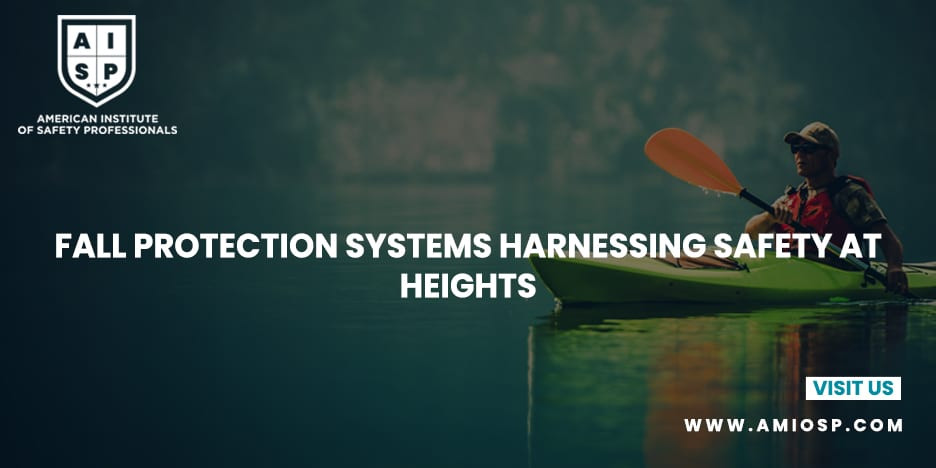Working at heights comes with inherent risks, making fall
protection systems a crucial aspect of ensuring the safety of workers. Falls
from elevated surfaces can result in severe injuries or even fatalities,
emphasizing the need for robust fall protection measures. In this blog post, we
will delve into the world of fall protection systems, exploring different types
of harnesses, their components, inspection requirements, and best practices for
their use. By harnessing safety at heights, we can create a secure working
environment for employees.
Understanding Fall Protection Systems
Fall protection systems are designed to prevent or arrest
falls, minimizing the potential for injuries. Among the various components of
fall protection systems, harnesses play a pivotal role in distributing forces
and supporting workers during a fall event. Harnesses consist of straps,
buckles, D-rings, and other attachment points that secure the worker to an
anchor point.
Types of Harnesses
There are several types of harnesses available, each
designed for specific working conditions and applications. The most common
types include:
1. Full-Body Harness: A full-body harness is the most
versatile and widely used type of harness. It distributes forces throughout the
body, reducing the risk of injury during a fall. Full-body harnesses typically
feature shoulder straps, leg straps, a waist belt, and a dorsal attachment
point. They are suitable for a wide range of work environments, including
construction sites, manufacturing facilities, and maintenance tasks.
2. Suspension Harness: Suspension harnesses are
designed for situations where workers may be suspended in an upright position
for an extended period. These harnesses have additional padding and support
around the thighs, buttocks, and waist to enhance comfort during the suspension.
Suspension harnesses are commonly used in activities such as window cleaning,
painting, and tower climbing.
3. Positioning Harness: Positioning harnesses are
intended for tasks that require workers to maintain specific positions for
extended periods. These harnesses have additional padding and support in the
seating area to reduce discomfort and pressure points. Positioning harnesses are
commonly used in activities such as welding, assembly work, and tower
maintenance.
Components of a Harness
A harness consists of various components that work together
to ensure the safety and comfort of the wearer. These components include:
1. Shoulder Straps: Shoulder straps distribute forces
across the shoulders and upper torso, providing stability and support during a
fall.
2. Leg Straps: Leg straps secure the harness around
the worker's legs, preventing the harness from riding up during a fall.
3. Waist Belt: The waist belt provides additional
support and helps distribute forces evenly across the body.
4. Chest Strap: The chest strap connects the shoulder
straps, preventing them from slipping off the shoulders during a fall event.
5. Dorsal Attachment Point: The dorsal attachment
point is a metal or fabric ring located on the back of the harness. It serves
as the primary attachment point for lanyards or self-retracting lifelines
(SRLs).
6. Front Attachment Points: Some harnesses also
feature front attachment points, which allow for alternative attachment
configurations based on the specific work task.
Inspection and Maintenance
Regular inspection and maintenance of fall protection
harnesses are crucial to ensure their effectiveness and reliability. Before
each use, the harness should undergo a thorough inspection, checking for signs
of wear, damage, or improper functioning. Inspect the following:
1. Webbing and Stitching: Check for any frayed, cut,
or torn webbing. Ensure that the stitching is intact and shows no signs of unraveling.
2. Buckles and Fasteners: Inspect buckles and
fasteners for any signs of damage, deformation, or malfunction. Ensure that
they engage and release properly.
3. D-Rings and Attachment Points: Examine D-rings and
attachment points for cracks, deformation, or wear. Ensure that they are
securely attached to the harness.
4. Labels and Markings: Ensure that all required
labels and markings are present, legible, and up to date. These labels provide
essential information about the harness, such as weight capacity and compliance
with industry standards.
If any defects or concerns are identified during the
inspection, the harness should be taken out of service and replaced or repaired
as necessary. It is important to follow the manufacturer's guidelines for
maintenance and retire harnesses that have exceeded their recommended service
life.
Best Practices for Harness Use
While fall protection harnesses are designed to enhance
safety, their effectiveness relies on proper use and adherence to best
practices. Here are some essential considerations:
1. Proper Fit: A harness should fit snugly and
comfortably on the worker's body. Adjust the straps and buckles to ensure a
secure and customized fit, without causing undue pressure points or restricting
movement.
2. Anchorage Points: Select appropriate anchor points
that are capable of supporting the anticipated load. Ensure that the anchor
point is securely attached and positioned to minimize free-fall distances.
3. Lanyard Selection: Choose the appropriate lanyard
based on the specific work task and conditions. Consider factors such as
length, shock absorption, and connection mechanisms.
4. Donning and Doffing: Workers should be trained in
proper donning and doffing techniques to ensure that the harness is correctly
worn and removed. Incorrect donning can compromise the effectiveness of the
harness.
5. Regular Training and Supervision: Provide
comprehensive training to workers on the proper use of fall protection
harnesses and systems. Supervise and monitor employees to ensure compliance
with safety protocols.
Conclusion
Fall protection systems, with harnesses as their key
component, are instrumental in mitigating the risk of falls and safeguarding
workers at heights. By understanding the different types of harnesses, their
components, inspection requirements, and best practices for their use,
employers can establish a culture of safety and prioritize the well-being of
their employees. Remember, the effectiveness of fall protection systems relies
on proper training, regular inspections, and adherence to industry standards.
Harness safety at heights, and let's ensure a secure and productive working
environment for all.












0 comments
No Comments